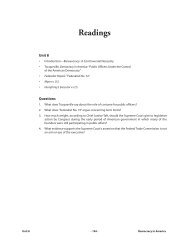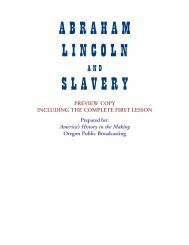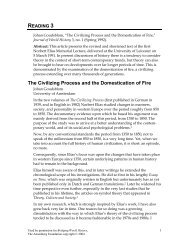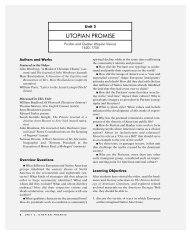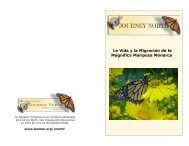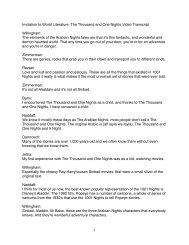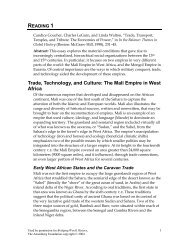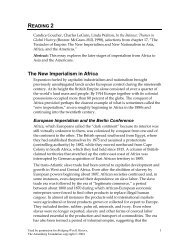Create successful ePaper yourself
Turn your PDF publications into a flip-book with our unique Google optimized e-Paper software.
Kashmiri shawls were favorite nineteenth-century wedding gifts in France as<br />
well as in Britain. Napoleon’s wedding gifts to Marie-Louise, his second wife,<br />
included seventeen Kashmiri shawls, and a painting of the guests at their<br />
1810 wedding showed many of the women with “a cashmere shawl carefully<br />
folded over one arm” (Levi-Strauss 1988, 19). Wealthy Frenchmen often<br />
presented a “fine cashmere shawl… [as] part of la corbeille, the groom’s gifts<br />
to his bride; and this item was frequently the most valuable among the<br />
women’s clothing in the inventories [of household possessions]” (Walton, 99).<br />
Unmarried nineteenth-century French women, no matter how wealthy, were<br />
discouraged from wearing Kashmiri shawls, for to do so would “lead people<br />
to believe that they are possessed of an unbridled love of luxury and deprive<br />
themselves of the pleasure of receiving such finery from a husband” (1863<br />
deportment manual cited by Perrot 1994, 100).<br />
Euro-American women on the northeastern coast of the United States started<br />
to wear Kashmiri shawls about the same time that they became fashionable in<br />
Britain. When trade with the European empires was curtailed for the new<br />
country in the aftermath of the Revolutionary [End Page 39] War, American<br />
ships sought out new markets in Asia. Kashmiri shawls reached the United<br />
States in the 1780s and 1790s when ship captains bound for China and Turkey<br />
acquired them in various ports of call (Dow 19<strong>21</strong>, 114). Some still unknown<br />
but no doubt changing mixture of Iranian, Kashmiri, north Indian, and<br />
western European-made shawls, as well as shawls from China, were available<br />
in U.S. eastern cities during the first half of the nineteenth century (Leavitt<br />
1972, 55; Harrington 1970, 4546; Bean 1990).<br />
Shawl fashion in the United States, as characterized in popular nineteenthcentury<br />
women’s magazines such as Godey’s Lady’s Book, published in<br />
Philadelphia, and Harper’s Bazaar, published in New York City, followed<br />
western European fashion trends. French shawls with imitation Kashmiri<br />
designs became widely available in the 1840s, and a decade later small-town<br />
stores commonly stocked embroidered shawls from “Thibet,” although it is<br />
impossible to know if this geographical designation referred to shawls from<br />
Kashmir or north India. An American advertisement in Godey’s Lady’s Book in<br />
1860 listed the types and prices of Indian shawls obtained from the East India<br />
company in London. These ranged from the least expensive, a “Delhi scarf for<br />
the shoulders” at $15, to square shawls, “ladylike and desirable” from $50 to<br />
$250, and reached the most expensive, “long shawls” costing as much as $1200.<br />
Shawls served as “attractive holiday presents” throughout the 1860s, and<br />
“India shawls were still considered wise purchases” in 1870. They continued<br />
thereafter to be advertised at all price ranges, with a new emphasis on the<br />
bottom end, and “imitation shawls were starting to eclipse the genuine Indian”<br />
in these advertisements by the end of the 1870s. Good quality shawls were then<br />
Used by permission for Bridging World History, 10<br />
The Annenberg Foundation copyright © 2004



